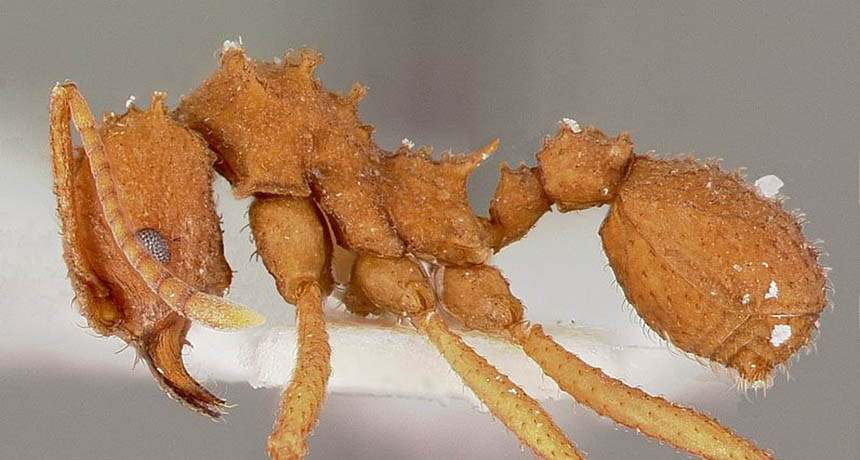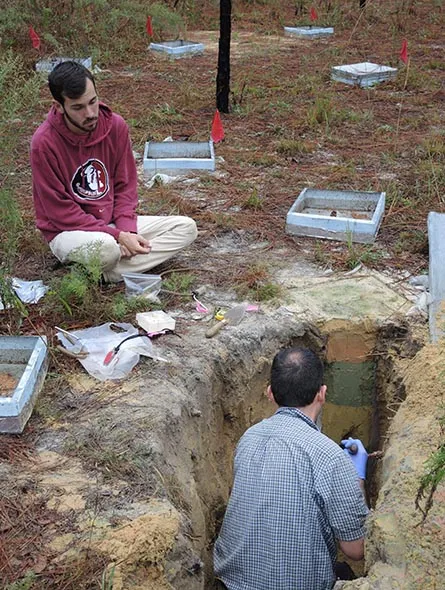Tiny ants move a ton of soil

Fungus-gardening ants build warrens of tunnels underground. A new study quantifies how much soil they can move — and it’s a lot.
April Nobile/© AntWeb.org/Wikimedia Commons (CC BY-SA 3.0)
- More than 2 years ago
Those little piles of dirt that ant colonies leave on the ground are an indication that ants are busy underground. And they’re moving more soil and sediment than you might think. A new study finds that, over a hectare, colonies of Trachymyrmex septentrionalis fungus-gardening ants in Florida can move some 800 kilograms aboveground and another 200 kilograms below in a year.
The question of how much soil and sand ants can move originated not with entomologists but with geologists and archaeologists. These scientists use a technique called optically stimulated luminescence, or OSL, to date layers of sediment. When minerals such as quartz are exposed to the sun, they suck up and store energy. Scientists can use the amount of energy in buried minerals to determine when they last sat on the surface, taking in the sun.
But ants might muck this up. To find out, a group of geologists and archaeologists reached out to Walter Tschinkel, an entomologist at Florida State University. Figuring out how much sand and soil ants dig up and deposit on the surface — called biomantling — is relatively easy, especially if the color of the soil they’re digging up is different from that found on the ground. But tracking movement underground, or bioturbation, is a bit more complicated.

Tschinkel and his former student Jon Seal, now an ecologist at the University of Texas at Tyler, turned to an area of the Apalachicola National Forest in Florida dubbed “Ant Heaven” for its abundant and diverse collection of ants. Tschinkel has worked there since the 1970s, and for the last six years, he has been monitoring some 450 colonies of harvester ants, which bring up plenty of sandy soil from underground. But he was also curious about the fungus-gardening ants.
Tschinkel and Seal had already shown that the fungus-gardening ant “is extremely abundant, that it moves a very large amount of soil, and that as the summer warms up, it digs a deeper chamber and deposits that soil in higher chambers without exposing it to light,” Tschinkel says. “In other words, it appeared to do a very large amount of soil mixing of the type [that had been] described in harvester ants.”
No one had ever quantified an ant colony’s subterranean digging before. Tschinkel and Seal started by digging 10 holes a meter deep and filling them with layers of native sand mixed with various colors of art sand — pink, blue, purple or yellow, green and orange, with plain forest sand at the top. Each hole was then topped with a cage, and an ant colony was transferred with the fungus that the ants cultivate like a crop. Throughout the experiment, the researchers collected sand that the ants deposited on the surface and provided the colonies with food for their fungus, including leaves, small flowers and oatmeal. Seven months later, Tschinkel and Seal carefully excavated the nine surviving ant colonies and quantified grains of sand moved from one sand layer to another. The team reports its findings July 8 in PLOS ONE.
By the end of the study, each ant colony had deposited an average of 758 grams of sand on the surface and moved another 153 grams between one colored layer and another underground, mostly upward. The ants dug chambers to farm their fungus, and they sometimes filled them up with sand from deeper layers as they dug new chambers in areas with temperature and humidity best suited for cultivation.
With more than a thousand nests per hectare, the ants may be moving about a metric ton of sand each year, covering the surface with 6 centimeters of soil over the course of a millennium, the researchers calculated.
All of this mixing and moving could prove a challenge for geologists and archaeologists relying on OSL. “When ants deposit sand from deeper levels at higher levels (or the reverse), they are mixing sand with different light-emitting capacity, and therefore with different measured ages,” Tschinkel notes. “People who use OSL need to know how much such mixing occurs, and then devise ways of dealing with it.” Now that scientists know that ants could be a problem, they should be able to develop ways to work around the little insects.





